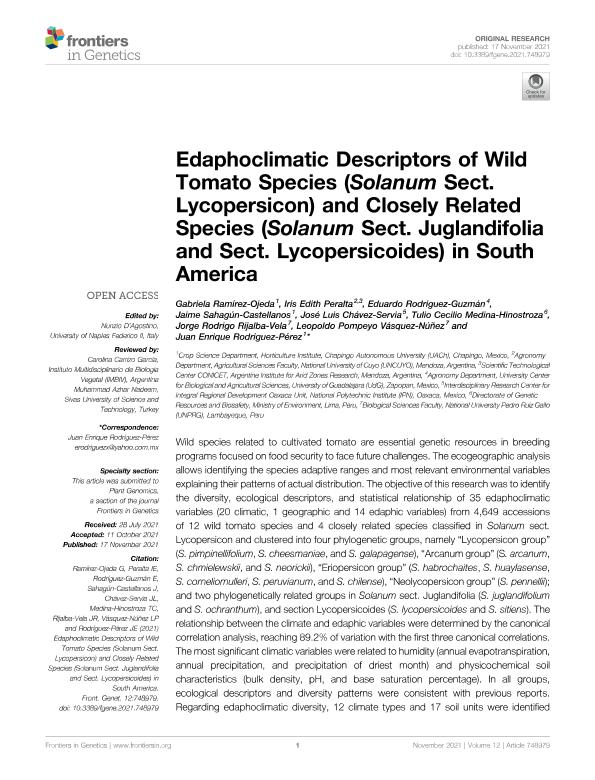Artículo
Edaphoclimatic descriptors of wild tomato species (Solanum Sect. Lycopersicon) and closely related species (Solanum Sect. Juglandifolia and Sect. Lycopersicoides) in South America
Ramírez Ojeda, Gabriela; Peralta, Iris Edith ; Rodríguez Guzmán, Eduardo; Sahagún Castellanos, Jaime; Chávez Servia, José Luis; Medina Hinostroza, Tulio Cecilio; Rijalba Vela, Jorge Rodrigo; Vásquez Núñez, Leopoldo Pompeyo; Rodríguez Pérez, Juan Enrique
; Rodríguez Guzmán, Eduardo; Sahagún Castellanos, Jaime; Chávez Servia, José Luis; Medina Hinostroza, Tulio Cecilio; Rijalba Vela, Jorge Rodrigo; Vásquez Núñez, Leopoldo Pompeyo; Rodríguez Pérez, Juan Enrique
 ; Rodríguez Guzmán, Eduardo; Sahagún Castellanos, Jaime; Chávez Servia, José Luis; Medina Hinostroza, Tulio Cecilio; Rijalba Vela, Jorge Rodrigo; Vásquez Núñez, Leopoldo Pompeyo; Rodríguez Pérez, Juan Enrique
; Rodríguez Guzmán, Eduardo; Sahagún Castellanos, Jaime; Chávez Servia, José Luis; Medina Hinostroza, Tulio Cecilio; Rijalba Vela, Jorge Rodrigo; Vásquez Núñez, Leopoldo Pompeyo; Rodríguez Pérez, Juan Enrique
Fecha de publicación:
11/2021
Editorial:
Frontiers Media
Revista:
Frontiers in Genetics
ISSN:
1664-8021
Idioma:
Inglés
Tipo de recurso:
Artículo publicado
Clasificación temática:
Resumen
Wild species related to cultivated tomato are essential genetic resources in breeding programs focused on food security to face future challenges. The ecogeographic analysis allows identifying the species adaptive ranges and most relevant environmental variables explaining their patterns of actual distribution. The objective of this research was to identify the diversity, ecological descriptors, and statistical relationship of 35 edaphoclimatic variables (20 climatic, 1 geographic and 14 edaphic variables) from 4,649 accessions of 12 wild tomato species and 4 closely related species classified in Solanum sect. Lycopersicon and clustered into four phylogenetic groups, namely “Lycopersicon group” (S. pimpinellifolium, S. cheesmaniae, and S. galapagense), “Arcanum group” (S. arcanum, S. chmielewskii, and S. neorickii), “Eriopersicon group” (S. habrochaites, S. huaylasense, S. corneliomulleri, S. peruvianum, and S. chilense), “Neolycopersicon group” (S. pennellii); and two phylogenetically related groups in Solanum sect. Juglandifolia (S. juglandifolium and S. ochranthum), and section Lycopersicoides (S. lycopersicoides and S. sitiens). The relationship between the climate and edaphic variables were determined by the canonical correlation analysis, reaching 89.2% of variation with the first three canonical correlations. The most significant climatic variables were related to humidity (annual evapotranspiration, annual precipitation, and precipitation of driest month) and physicochemical soil characteristics (bulk density, pH, and base saturation percentage). In all groups, ecological descriptors and diversity patterns were consistent with previous reports. Regarding edaphoclimatic diversity, 12 climate types and 17 soil units were identified among all species. This approach has promissory applications for biodiversity conservation and uses valuable genetic resources related to a leading crop.
Archivos asociados
Licencia
Identificadores
Colecciones
Articulos(IADIZA)
Articulos de INST. ARG DE INVEST. DE LAS ZONAS ARIDAS
Articulos de INST. ARG DE INVEST. DE LAS ZONAS ARIDAS
Citación
Ramírez Ojeda, Gabriela; Peralta, Iris Edith; Rodríguez Guzmán, Eduardo; Sahagún Castellanos, Jaime; Chávez Servia, José Luis; et al.; Edaphoclimatic descriptors of wild tomato species (Solanum Sect. Lycopersicon) and closely related species (Solanum Sect. Juglandifolia and Sect. Lycopersicoides) in South America; Frontiers Media; Frontiers in Genetics; 12; 11-2021; 1-16
Compartir
Altmétricas



